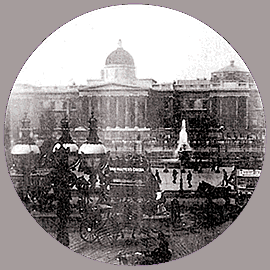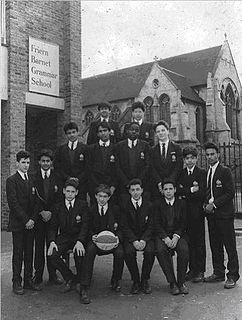See also
| This page lists people with the surname Friese-Greene. If an internal link intending to refer to a specific person led you to this page, you may wish to change that link by adding the person's given name(s) to the link. |
Friese-Greene may refer to:
| This page lists people with the surname Friese-Greene. If an internal link intending to refer to a specific person led you to this page, you may wish to change that link by adding the person's given name(s) to the link. |

William Friese-Greene was a prolific English inventor and professional photographer. He is principally known as a pioneer in the field of motion pictures, creating a series of cameras in the period 1888–1891 with which he shot moving pictures in London. He went on to patent an early two-colour filming process in 1905. His inventions in the field of printing – including photo-typesetting and a method of printing without ink – brought him wealth, as did his chain of photographic studios. However, he spent everything he earned on inventing, going bankrupt three times and being jailed once, before dying in poverty.

Richard Marius Joseph Greene was a noted English film and television actor. A matinée idol who appeared in more than 40 films, he was perhaps best known for the lead role in the long-running British TV series The Adventures of Robin Hood, which ran for 143 episodes from 1955 to 1959.

Talk Talk were an English band formed in 1981, led by Mark Hollis, Lee Harris (drums), and Paul Webb (bass). The group achieved early chart success with the synth-pop singles "Talk Talk" (1982), "It's My Life", and "Such a Shame" before moving towards more experimental music in the mid-1980s, pioneering what became known as post-rock. Talk Talk achieved widespread critical success in Europe and the UK with the singles "Life's What You Make It" (1985), and "Living in Another World" (1986), and in 1988 they released their fourth album Spirit of Eden, which was critically acclaimed yet commercially less successful.

Natural History: The Very Best of Talk Talk is a 1990 greatest hits album by Talk Talk. It collects songs that the band released under EMI between 1982 and 1988.

The following is an overview of the events of 1890 in film, including a list of films released and notable births and deaths.

Kinemacolor was the first successful colour motion picture process, used commercially from 1908 to 1914. It was invented by George Albert Smith of Brighton, England in 1906. He was influenced by the work of William Norman Lascelles Davidson and, more directly, Edward Raymond Turner. It was launched by Charles Urban's Urban Trading Co. of London in 1908. From 1909 on, the process was known as Kinemacolor. It was a two-colour additive colour process, photographing and projecting a black-and-white film behind alternating red and green filters.
The following is an overview of the events of 1889 in film, including a list of films released and notable births.

The Magic Box is a 1951 British Technicolor biographical drama film directed by John Boulting. The film stars Robert Donat as William Friese-Greene, with a host of cameo appearances by actors including Peter Ustinov and Laurence Olivier. It was produced by Ronald Neame and distributed by British Lion Film Corporation. The film was a project of the Festival of Britain and adapted by Eric Ambler from the controversial biography by Ray Allister.
William Greene may refer to:
Claude Friese-Greene was a British-born cinema technician, filmmaker and cinematographer, most famous for his 1926 collection of films entitled The Open Road.
Timothy Alan Friese-Greene is an English musician and producer. He worked with the band Talk Talk from 1983 to their breakup in 1991. He currently releases solo albums under the name "Heligoland". He is the grandson of filmmaker Claude Friese-Greene and great-grandson of photographer and inventor William Friese-Greene.

Leisurely Pedestrians, Open Topped Buses and Hansom Cabs with Trotting Horses is a 1889 British short silent actuality film, shot by inventor and film pioneer William Friese-Greene on celluloid film using his 'machine' camera. The 20 feet of film, which was shot in autumn 1889 at Apsley Gate, Hyde Park, London, was claimed to be the first motion picture, although Louis Le Prince successfully shot on glass plate before 18 August 1887, and on paper negative in October 1888. It may nonetheless be the first moving picture film on celluloid and the first shot in London. It was never publicly screened, although several photographic journalists saw it during his lifetime — including Thomas Bedding, J. Hay Taylor and Theodore Brown. It is now considered a lost film with no known surviving prints and only one possible still image extant.
The Lost World of Friese-Greene is a BBC documentary series produced in conjunction with the British Film Institute. Three one-hour episodes were broadcast on BBC Two in spring 2006.

The Friern Barnet Grammar School was a small independent day school for boys located on Friern Barnet Road, North London.
Friese may refer to:
Many Tanks Mr. Atkins is a 1938 British comedy war film directed by Roy William Neill and starring Claude Hulbert, Reginald Purdell and Barbara Greene.
John Arthur Roebuck Rudge was a British instrument maker and inventor, noted for his contributions to cinematography. He collaborated with William Friese-Greene and in 1875, he invented the Rudge Projector, known as the Biophantic Lantern, further developed and enhanced as the Biophantascope, or Phantascope.

William Greene Jr. was the second governor of the state of Rhode Island, serving in this capacity for eight years, five of which were during the American Revolutionary War. From a prominent Rhode Island family, his father, William Greene Sr., had served 11 terms as a colonial governor of Rhode Island. His great-grandfather, John Greene Jr. served for ten years as deputy governor of the colony, and his great-great-grandfather, John Greene Sr. was a founding settler of both Providence and Warwick.
Arthur Albert 'Esme' Collings was an English photographer, miniaturist and the first of the loose association of early film pioneers dubbed the Brighton School by French film historian Georges Sadoul. Collings, whose interest in cinematography may have stemmed from his business association with fellow film pioneer William Friese-Greene, was only active in film production for about a year, has left little trace and is, according to film historian Rachael Low, of local importance only.
Brighton School was a loosely associated group of pioneering filmmakers active in the Brighton and Hove area of England from 1896 to 1910. The core membership of the group consists of filmmakers George Albert Smith, James Williamson and Esmé Collings as well as engineer Alfred Darling; other names associated with the group include Collings' former business partner William Friese-Greene and the group's London-based distributor Charles Urban. The term was coined by French film historian Georges Sadoul in an article that was translated and re-published in pamphlet form as British Creators of Film Technique by the British Film Institute in 1948.